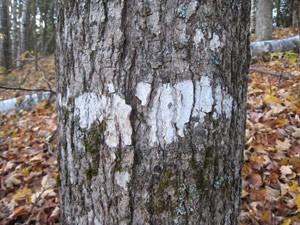Those white paint-like bands across the bark are lichens, and they are as normal and natural a part of healthy forests as are warblers. There are several others present on this tree and throughout the woods. Lichens exist in beautiful diversity, and the vast majority of them do absolutely no harm to trees. Better still, lichens play several vital roles in the forest, from water and nutrient cycling to providing food for mammals, nest materials for birds, cover for mites, and camouflage for tree frogs and lacewings. Some are even used by scientists as indicators of air quality. Lichens are good.
They escape simple description, though, because they do not quite fit into normal categories of plant classification. Technically, lichens are not plants at all. They are not mosses either (though what we call “reindeer moss” is a lichen and true mosses often grow on tree bark with lichens (Indeed, the darkest green in this photo is moss). In fact, a lichen is not even a single entity. It is a composite of two different organisms functioning as one.
A typical lichen is a fungus and an alga or cyanobacterium living together in a biological relationship. Yes, right there in plain sight on your tree’s bark. Because the fungus lacks chlorophyll – the green pigment capable of using carbon dioxide and water in the presence of light to make sugars through photosynthesis – it can’t make its own food. But it is able to use the carbohydrates produced by its resident algae. In return, the alga receives from the fungus a structure (a stable home) and a steady supply of water and dissolved nutrients absorbed from the atmosphere and the substrate (in this case the surface of the tree’s bark). As one scholar put it, lichens are fungi that have discovered agriculture.
This relationship of fungi living with algae works, and the partners seem to get along well enough; worldwide there are more than 14,000 species of lichen existing in a wide range of sizes, forms, and colors. They can be found thriving together in an astounding range of environments – from intertidal zones to mountain summits – and on all manner of substrates, from bare rock to tree bark. Some have even been found growing on the backs of living insects.
Still, not all lichens are models of biological harmony, a purely mutualistic symbiosis where both organisms benefit and neither suffers. In some lichens, when the fungus uses a large percentage of what its alga produces, there would seem to be a high degree of parasitism. Yet the fungi and the algae that occur together as lichens are rarely found living independently on their own, suggesting that both organisms gain something by becoming lichenized. Although the algae are sometimes killed as well as robbed, in all lichens, the algal cells can reproduce faster than they are destroyed, and so the relationship lives. Good thing, too, for otherwise, the fungus would eat itself into oblivion.
And what about the trees upon which some lichen species grow: are they truly innocent bystanders to this fungal-algal relationship? Do the trees merely provide a nice above-ground substrate and suffer no ill effects at all? It’s an excellent question, given that we know that the crust-like lichens inhabiting bare rock are capable of chemically and mechanically weathering and breaking down those rocks over time. If they can wear down bedrock, surely lichens on bark must be inflicting some kind of damage to the trees, right? After all, lichens do also seem particularly abundant on dying and dead trees. It really does beg the question: are they responsible for that tree mortality or just responding to it?
It is plausible that lichen parts or substances may enter a tree’s vascular system through its bark and could thereby cause physiological harm to the tree. But if it does happen, it would appear to be the exception. There are no confirmed reports linking lichens with tree decline or mortality. Instead, increases in lichen abundance on sick and dead trees are thought to be less a direct result of the lichens’ presence and more a favorable growth response by some lichens to the increased light reaching the host tree’s stems and branches after losing leaves above. Then again, some lichen species clearly do quite well under lower light conditions. And as any woods walk will prove, there are lichens – one kind or another – growing on just about every tree surface be it dead, living, dying, or thriving.



Discussion *